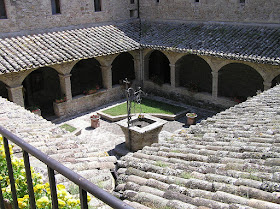In every monastery, of nuns or of monks, there is an area normally reserved only for residents of the monastic community. This is called “the cloister” or “enclosure.”
In the analogy of the cloistered heart, we are invited into an enclosure beyond all of our loftiest mental images.
The fact is: if we’re human beings, we are called to live within the will of God.
In our analogy of "the cloistered heart," I am invited to live within the boundaries of God's will as a nun would live inside her enclosure. A potential cloistered nun does not set the boundaries of enclosure for herself, saying that she really prefers other areas, thank you very much. No, she accepts them as they have already been set up...or she goes elsewhere.
I look around, today, at the boundaries of my enclosure. I don't have to map them out for myself; they are clearly defined for me in Scripture and in 2,000 years of authentic Church discernment.
Sometimes we can fear the boundaries of God's will, worrying that they'll sap all joy and pleasure from our lives. The saints tell us otherwise.
“Freed from the heavy burden of my own will, I may breathe freely under the light load of love…” (St. Bernard of Clairvaux)
“Do you want to be free? Then free yourself by your own act; have no will but God’s will.” (La Trappe in England by a Religious of Holy Cross Abbey, 1937)
I Choose the Wall
It's just a bit different when it comes to the doing of it. Oh, it's not so bad when God's will and mine are precisely the same. But at some point(s), my will and God's are going to conflict.
What happens then?
I look at the "walls" of God's will - the boundaries in which I am "enclosed" if I genuinely want to live for Him. I think about what the Church teaches on particular subjects. I consider Scripture. Oh my: there are some tough things to live up to in Scripture! Pray for my persecutors? Love my neighbor as myself? Do not judge?!
Sometimes I find myself picking and choosing. I'll live this commandment, but not that other one. I'll go right along with this chapter in the Catechism, but surely I'm not expected to take that one seriously. I mean, who does?
If I intend to live cloistered in heart, then I must be the one. I don't just go grabbing stones out of my enclosure wall. For if I do, it won't be long before that wall - that high, beloved wall built by Our Lord Himself to protect me - comes swiftly tumbling down. And I am left unprotected, unshielded, vulnerable to attacks on my life, my spirit, my immortal soul.
God's will and mine are going to conflict. At various points, this is going to happen. In order for me to choose God's will for Him and not just for my own self-interest, this HAS to happen.
For if God's will and mine are always the same, how could I make a truly free choice for His?
"Don't lose heart, I entreat you; gradually train your will to follow God's will wherever it leads." (St. Francis de Sales)








